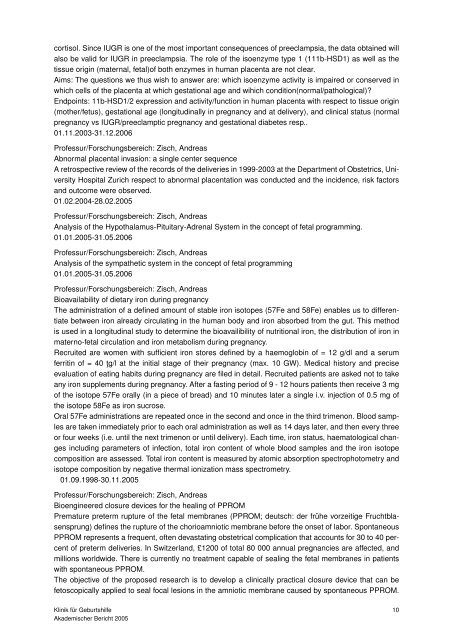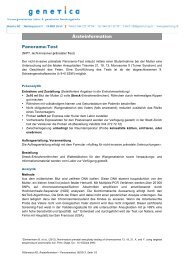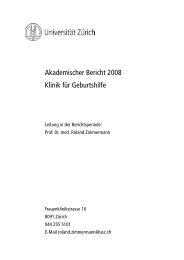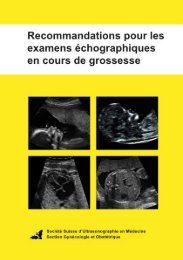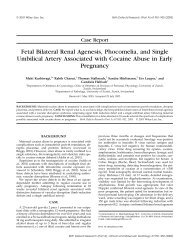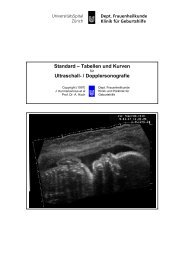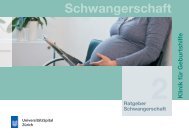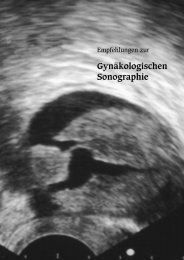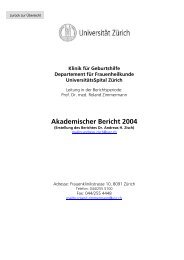Akademischer Bericht 2005 - Geburtshilfe - UniversitätsSpital Zürich
Akademischer Bericht 2005 - Geburtshilfe - UniversitätsSpital Zürich
Akademischer Bericht 2005 - Geburtshilfe - UniversitätsSpital Zürich
Erfolgreiche ePaper selbst erstellen
Machen Sie aus Ihren PDF Publikationen ein blätterbares Flipbook mit unserer einzigartigen Google optimierten e-Paper Software.
cortisol. Since IUGR is one of the most important consequences of preeclampsia, the data obtained will<br />
also be valid for IUGR in preeclampsia. The role of the isoenzyme type 1 (111b-HSD1) as well as the<br />
tissue origin (maternal, fetal)of both enzymes in human placenta are not clear.<br />
Aims: The questions we thus wish to answer are: which isoenzyme activity is impaired or conserved in<br />
which cells of the placenta at which gestational age and wihich condition(normal/pathological)<br />
Endpoints: 11b-HSD1/2 expression and activity/function in human placenta with respect to tissue origin<br />
(mother/fetus), gestational age (longitudinally in pregnancy and at delivery), and clinical status (normal<br />
pregnancy vs IUGR/preeclamptic pregnancy and gestational diabetes resp..<br />
01.11.2003-31.12.2006<br />
Professur/Forschungsbereich: Zisch, Andreas<br />
Abnormal placental invasion: a single center sequence<br />
A retrospective review of the records of the deliveries in 1999-2003 at the Department of Obstetrics, University<br />
Hospital Zurich respect to abnormal placentation was conducted and the incidence, risk factors<br />
and outcome were observed.<br />
01.02.2004-28.02.<strong>2005</strong><br />
Professur/Forschungsbereich: Zisch, Andreas<br />
Analysis of the Hypothalamus-Pituitary-Adrenal System in the concept of fetal programming.<br />
01.01.<strong>2005</strong>-31.05.2006<br />
Professur/Forschungsbereich: Zisch, Andreas<br />
Analysis of the sympathetic system in the concept of fetal programming<br />
01.01.<strong>2005</strong>-31.05.2006<br />
Professur/Forschungsbereich: Zisch, Andreas<br />
Bioavailability of dietary iron during pregnancy<br />
The administration of a defined amount of stable iron isotopes (57Fe and 58Fe) enables us to differentiate<br />
between iron already circulating in the human body and iron absorbed from the gut. This method<br />
is used in a longitudinal study to determine the bioavailibility of nutritional iron, the distribution of iron in<br />
materno-fetal circulation and iron metabolism during pregnancy.<br />
Recruited are women with sufficient iron stores defined by a haemoglobin of = 12 g/dl and a serum<br />
ferritin of = 40 ţg/l at the initial stage of their pregnancy (max. 10 GW). Medical history and precise<br />
evaluation of eating habits during pregnancy are filed in detail. Recruited patients are asked not to take<br />
any iron supplements during pregnancy. After a fasting period of 9 - 12 hours patients then receive 3 mg<br />
of the isotope 57Fe orally (in a piece of bread) and 10 minutes later a single i.v. injection of 0.5 mg of<br />
the isotope 58Fe as iron sucrose.<br />
Oral 57Fe administrations are repeated once in the second and once in the third trimenon. Blood samples<br />
are taken immediately prior to each oral administration as well as 14 days later, and then every three<br />
or four weeks (i.e. until the next trimenon or until delivery). Each time, iron status, haematological changes<br />
including parameters of infection, total iron content of whole blood samples and the iron isotope<br />
composition are assessed. Total iron content is measured by atomic absorption spectrophotometry and<br />
isotope composition by negative thermal ionization mass spectrometry.<br />
01.09.1998-30.11.<strong>2005</strong><br />
Professur/Forschungsbereich: Zisch, Andreas<br />
Bioengineered closure devices for the healing of PPROM<br />
Premature preterm rupture of the fetal membranes (PPROM; deutsch: der frühe vorzeitige Fruchtblasensprung)<br />
defines the rupture of the chorioamniotic membrane before the onset of labor. Spontaneous<br />
PPROM represents a frequent, often devastating obstetrical complication that accounts for 30 to 40 percent<br />
of preterm deliveries. In Switzerland, £1200 of total 80 000 annual pregnancies are affected, and<br />
millions worldwide. There is currently no treatment capable of sealing the fetal membranes in patients<br />
with spontaneous PPROM.<br />
The objective of the proposed research is to develop a clinically practical closure device that can be<br />
fetoscopically applied to seal focal lesions in the amniotic membrane caused by spontaneous PPROM.<br />
Klinik für <strong>Geburtshilfe</strong><br />
<strong>Akademischer</strong> <strong>Bericht</strong> <strong>2005</strong><br />
10


